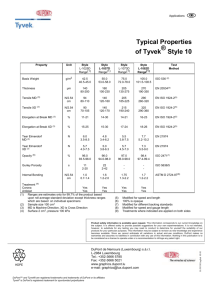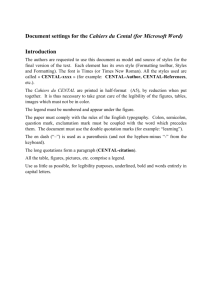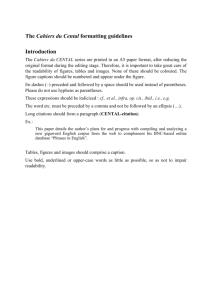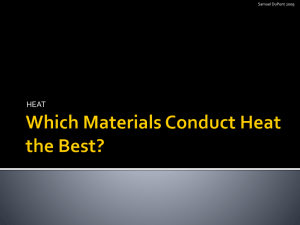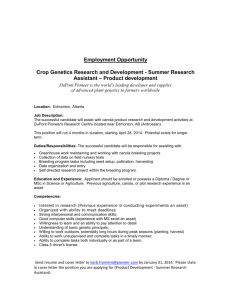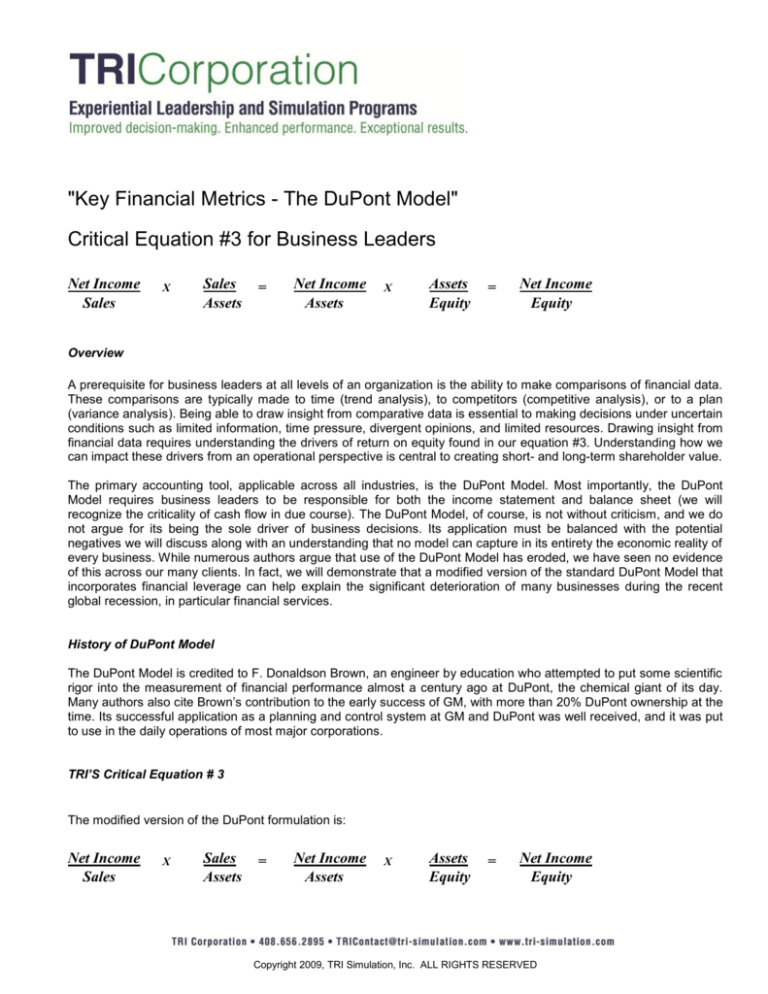
"Key Financial Metrics - The DuPont Model"
Critical Equation #3 for Business Leaders
Net Income
Sales
X
Sales
Assets
=
Net Income
Assets
X
Assets
Equity
=
Net Income
Equity
Overview
A prerequisite for business leaders at all levels of an organization is the ability to make comparisons of financial data.
These comparisons are typically made to time (trend analysis), to competitors (competitive analysis), or to a plan
(variance analysis). Being able to draw insight from comparative data is essential to making decisions under uncertain
conditions such as limited information, time pressure, divergent opinions, and limited resources. Drawing insight from
financial data requires understanding the drivers of return on equity found in our equation #3. Understanding how we
can impact these drivers from an operational perspective is central to creating short- and long-term shareholder value.
The primary accounting tool, applicable across all industries, is the DuPont Model. Most importantly, the DuPont
Model requires business leaders to be responsible for both the income statement and balance sheet (we will
recognize the criticality of cash flow in due course). The DuPont Model, of course, is not without criticism, and we do
not argue for its being the sole driver of business decisions. Its application must be balanced with the potential
negatives we will discuss along with an understanding that no model can capture in its entirety the economic reality of
every business. While numerous authors argue that use of the DuPont Model has eroded, we have seen no evidence
of this across our many clients. In fact, we will demonstrate that a modified version of the standard DuPont Model that
incorporates financial leverage can help explain the significant deterioration of many businesses during the recent
global recession, in particular financial services.
History of DuPont Model
The DuPont Model is credited to F. Donaldson Brown, an engineer by education who attempted to put some scientific
rigor into the measurement of financial performance almost a century ago at DuPont, the chemical giant of its day.
Many authors also cite Brown’s contribution to the early success of GM, with more than 20% DuPont ownership at the
time. Its successful application as a planning and control system at GM and DuPont was well received, and it was put
to use in the daily operations of most major corporations.
TRI’S Critical Equation # 3
The modified version of the DuPont formulation is:
Net Income
Sales
X
Sales
Assets
=
Net Income
Assets
X
Assets
Equity
=
Net Income
Equity
Copyright 2009, TRI Simulation, Inc. ALL RIGHTS RESERVED
To begin to appreciate the formulation, imagine that the only information you have is given in Exhibit 1.
Exhibit 1
An alternative to this question is “If you had to design a system to measure your performance that you would be
accountable for and possibly incentivized on, what might those measurements be, given the lack of breakdown of
costs and assets?”
Five fundamental ratios would fall out of the analysis. These are given in Exhibit 2.
Exhibit 2
Copyright 2009, TRI Simulation, Inc. ALL RIGHTS RESERVED
The five financial ratios are Return on Sales (ROS), Asset Turns, Return on Assets (ROA), Financial Leverage, and
Return on Equity (ROE).
The original DuPont Model is actually Return on Sales multiplied by Asset Turns equals Return on Assets. Exhibit 3
depicts these primary drivers.
Exhibit 3
From a management perspective, the primary benefits of understanding the DuPont Model are the trend and
competitive analysis and understanding their drivers, some controllable, some not controllable depending on the
industry. Variance analysis (prior year to plan, plan to actual, and prior year to actual) are the topic of TRI’s Critical
Equations #1 and # 2 (see prior newsletters and/or www.tri-simulation.com).
Return on Sales (of after-tax profit margin) can be deconstructed into other margins such as contribution margin,
operating margin, gross margin, EBIT, or EBT. Similarly, Asset Turns can be divided into working capital turns,
receivable turns, inventory turns, and fixed asset turns. Financial Leverage, or Gearing Ratio as it is often referred to
outside the U.S., magnifies the gains or losses associated with ROA. Operating Leverage is the percentage change in
operating profit divided by the percentage change in sales.
The key driver of operating leverage is the ratio of fixed to variable costs. An increase in fixed relative to variable costs
will result in greater operating leverage with a commensurate increase in risk. The risk derives from declines in sales
against the fixed cost. High degrees of Operating Leverage coupled with Financial Leverage, often seen in industries
such as automobile manufacturing and hotels, can be risky, depending on the volatility of drivers such as price,
volume, etc. Public utilities have significant Operating and Financial Leverage, but regulation plus low elasticity of
demand mitigate to some degree the combined potential negative leverage.
Most of the volatility in ROE over time typically comes from change in the margin (Asset Turns and Financial
Leverage tend to be more stable across time for most industries). When low on ROS, most industries tend to be high
Copyright 2009, TRI Simulation, Inc. ALL RIGHTS RESERVED
on Asset Turns. Grocery stores, for example, have low margins due to competition but are profitable because of
volume. Or the after-market can provide the profitability in lower margins on initial sale. A converse example is a
business producing diesel electric locomotives, which has significant margins over the product life cycle with lower
turns due to capital intensity and lower volumes. As a test, check out the inventory turns in a business that produces a
very complex product like an airplane.
Sustainability and differentiation are fundamental to business strategy. No business that can sustain high ROA
indefinitely. Businesses that come close have both t (high margins) and f (volume). Consistent excess returns,
however, eventually attract others, be it competition or a regulatory body. Because of the “human factor,”
organizational success often results in a resistance to change or worse, institutional arrogance. An industry with
consistently high ROAs is pharmaceuticals, at least historically. How about Google over the next decade?
Test you knowledge of industry dynamics and the DuPont Model in Exhibit 4. Which business is in Manufacturing?
Which is the Financial Service business? Note: the ROE is identical while how we got there may be significantly
different.
Exhibit 4
With significant margins and low degrees of financial leverage, A is Manufacturing. Financial Services, due to intense
competition in pricing, have much lower ROAs (often called RO s) but make significant use of borrowed monies or
leverage. Think about our recent experience. Increases in defaults on all classifications of loans layered on top of little
equity leaves little margin for error. Of course, this is at the heart of Basel II and potential financial regulation being
debated by Congress. Numerous websites and textual materials are available that will compare, from a DuPont
perspective, both within and amongst industry comparisons. Another interesting application of the DuPont Model is
with the so-called ISO-ROA maps. The prime advantage of the ISO-ROA application is the ease of seeing within and
amongst industry comparisons and/or across time within an organization in a graphical form.
An Example
One application of financial measures in the DuPont Model is to look at data trends to understand the drivers of any
positive or negative change. In Exhibit 5, complete the boxes given the financial time series. Do you like this
Copyright 2009, TRI Simulation, Inc. ALL RIGHTS RESERVED
business? Would you buy this business? While this is not a complete due diligence, based on the ROS, Asset Turns
and ROA, what inference can you draw?
Exhibit 5
Income Statements & Financial Ratios
-
Year 1
Year 2
Year 3
Sales
Costs
Earnings
$100
-95
$5
$140
-126
$14
$200
-170
$30
Assets
$100
$125
$160
Year 1
Year 2
Year 3
Asset Turnover (TURNS)
Return on Assets (ROA)
Return on Sales (ROS)
Naturally, all of us would have expected and required additional information. In Exhibit 6, note how the growth rates
can be linked to the financial ratios. While the example is magnified because of the low base of $5 earnings in Year 1,
we can see that having the next level of margin grow at a faster rate than the prior level is critical in an income
statement. Imagine an income statement with variable and fixed costs. With variable cost productivity, the contribution
margin grows at a faster rate than sales. With fixed cost productivity, the operating margin grows at a faster rate than
the contribution margin. This is the classic example of Operating Leverage.
Exhibit 6
Income Statements & Financial Ratios
-
Year 1
Year 2
Year 3
Sales
Costs
Earnings
$100
-95
$5
$140
-126
$14
$200
-170
$30
Assets
$100
$125
$160
Year 1
Year 2
Year 3
5%
10%
Asset Turnover (TURNS)
1x
1.12x
1.25x
Return on Assets (ROA)
5%
11.2% 18.75%
Return on Sales (ROS)
15%
Would you buy this company?
Copyright 2009, TRI Simulation, Inc. ALL RIGHTS RESERVED
Growth
Rate (1-3)
100%
79%
500%
60%
However, the balance sheet in Exhibit 7 reveals a cash flow issue that might not be obvious in Exhibit 6 and, from a
market value perspective, a lack of quality of earnings, and a disconnect in net income and cash flow. This
demonstrates the importance of drilling down and taking cash flow into account.
Exhibit 7
Balance Sheets
Sales
$100
$140
$200
100%
Cash
Receivables
Inventory
Plant/Equipment
Total Assets
Year1 Year 2 Year 3
$30
$15
$2
20
40
60
10
25
48
40
45
50
$100
$125
$160
-93%
200%
380%
25%
Debt
Equity
Debt and Equity
Year1 Year 2 Year 3
$50
$61
$66
50
64
94
$100
$125
$160
Where is the cash?
DuPont Model, Leverage and Growth
The concept of sustainable growth often is applied to the market valuation of equity and other long-term investments.
When calculating value in Discounted Cash Flow models, a sustainable growth rate often is used for the benefit of
simplicity. Sustainable growth is the maximum growth in net income we can achieve given assumptions on margins,
turns, and financial leverage (referred to as the equity multiplier in Exhibit 8). An alternative arrangement of the
DuPont Model with financial leverage is at the bottom of Exhibit 8 (we will gladly supply a derivation upon request).
This variation is framed in terms of a new financial metric called Return on Total Capital or ROTC. ROTC is the net
operating profit after tax (unlevered net income or NOPAT) divided by the total capital (sum of shareholders equity
and interest-bearing debt). Sustainable growth is the product of the retention rate of earnings (percentage of net
income reinvested in the business or one minus the payout ratio for dividends) and ROE.
Exhibit 8
Copyright 2009, TRI Simulation, Inc. ALL RIGHTS RESERVED
With an ROE of 15% and a retention rate of earning of 60%, the sustainable growth is 9%. If we assume, for the merit
of simplicity, that the price-to-earnings ratio was constant over time, share price would increase at the annual rate of
9%. The total shareholder return would be the sum of the 9% plus the dividend yield.
Positives and Negatives of DuPont in Practice
The positives of applying a DuPont formulation as a business leader are:
1.
2.
3.
4.
5.
Simplicity of use and communication
Linkage of income statement and balance sheets
Allows for comparisons to time (trend), competition (differentiation) and plan (execution risk)
Potential link to compensation (again with an understanding of cash flow)
From a risk perspective, see operational drivers -- some controllable, some not
The negatives, as we see it, are:
1.
2.
3.
4.
5.
6.
Accounting-based system with valuation primarily from an historical perspective,
No linkage to the cost of capital
Limited correlation to cash flow
No direct linkage to non-financial metrics unless specifically defined
Inability to apply at business unit and/or product line levels due to lack of balance sheet drill down
Accounting treatments may vary across the world so one needs to be careful with comparisons
Summary
Having survived nearly a century of application and debate, some positive and some negative, the DuPont Model can
provide business leaders at all levels insight to understand fundamental drivers of profitability and return on
investment. From TRI’s perspective, we believe the model has the merit of simplicity, allows everyone in an
organization to understand what they can influence when the income statement and balance sheet are properly
detailed, and, from a risk management perspective, enables the applications of variance analysis discussed in our
other business equations. As we’ve stated, no model can capture all aspects of business reality and must be viewed
in a systems perspective of other models. If you have questions or want more information on any of our business
equations, please contact us at TRIContact@tri-simulation.com.
Tri Corporation provides this note for educational purposes only. The information contained herein does not constitute legal, tax, accounting,
management, financial or investment advice and should not be used as a substitute for experiential training or consultation with professionals in
those disciplines. The information is provided "as is," and without warranty of any kind, express or implied, including but not limited to warranties of
performance, merchantability, and fitness for a particular purpose.
Copyright 2009, TRI Simulation, Inc. ALL RIGHTS RESERVED



